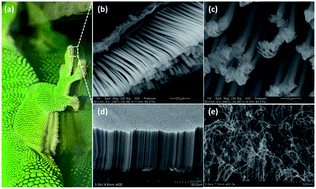Geckos can run freely on vertical walls and even ceilings. Recent studies have discovered that gecko's extraordinary climbing ability comes from a remarkable design of nature with nanoscale beta-keratin elastic hairs on their feet and toes, which collectively generate sufficiently strong van der Waals force to hold the animal onto an opposing surface while at the same time disengaging at will. Vertically aligned carbon nanotube (VA-CNT) arrays, resembling gecko's adhesive foot hairs with additional superior mechanical, chemical and electrical properties, have been demonstrated to be a promising candidate for advanced fibrillar dry adhesives. The VA-CNT arrays with tailor-made hierarchical structures can be patterned and/or transferred onto various flexible substrates, including responsive polymers. This, together with recent advances in nanofabrication techniques, could offer ‘smart’ dry adhesives for various potential applications, even where traditional adhesives cannot be used. A detailed understanding of the underlying mechanisms governing the material properties and adhesion performances is critical to the design and fabrication of gecko inspired CNT dry adhesives of practical significance. In this feature article, we present an overview of recent progress in both fundamental and applied frontiers for the development of CNT-based adhesives by summarizing important studies in this exciting field, including our own work.

You have access to this article
 Please wait while we load your content...
Something went wrong. Try again?
Please wait while we load your content...
Something went wrong. Try again?


 Please wait while we load your content...
Please wait while we load your content...